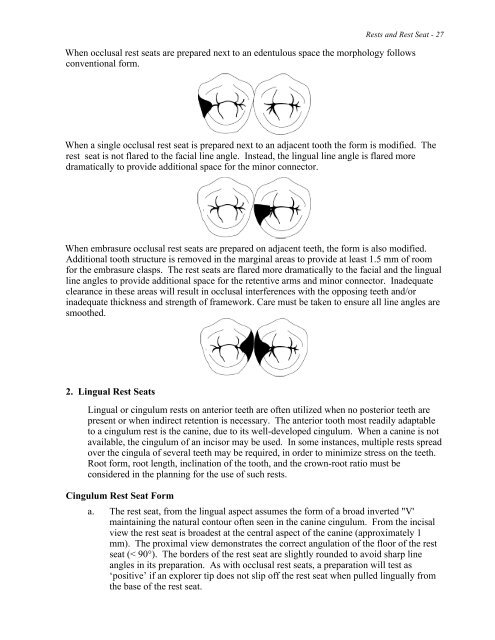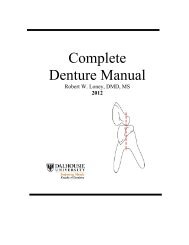RPD Manual 11 - Removable Prosthodontics - Dalhousie University
RPD Manual 11 - Removable Prosthodontics - Dalhousie University
RPD Manual 11 - Removable Prosthodontics - Dalhousie University
Create successful ePaper yourself
Turn your PDF publications into a flip-book with our unique Google optimized e-Paper software.
Rests and Rest Seat - 27<br />
When occlusal rest seats are prepared next to an edentulous space the morphology follows<br />
conventional form.<br />
When a single occlusal rest seat is prepared next to an adjacent tooth the form is modified. The<br />
rest seat is not flared to the facial line angle. Instead, the lingual line angle is flared more<br />
dramatically to provide additional space for the minor connector.<br />
When embrasure occlusal rest seats are prepared on adjacent teeth, the form is also modified.<br />
Additional tooth structure is removed in the marginal areas to provide at least 1.5 mm of room<br />
for the embrasure clasps. The rest seats are flared more dramatically to the facial and the lingual<br />
line angles to provide additional space for the retentive arms and minor connector. Inadequate<br />
clearance in these areas will result in occlusal interferences with the opposing teeth and/or<br />
inadequate thickness and strength of framework. Care must be taken to ensure all line angles are<br />
smoothed.<br />
2. Lingual Rest Seats<br />
Lingual or cingulum rests on anterior teeth are often utilized when no posterior teeth are<br />
present or when indirect retention is necessary. The anterior tooth most readily adaptable<br />
to a cingulum rest is the canine, due to its well-developed cingulum. When a canine is not<br />
available, the cingulum of an incisor may be used. In some instances, multiple rests spread<br />
over the cingula of several teeth may be required, in order to minimize stress on the teeth.<br />
Root form, root length, inclination of the tooth, and the crown-root ratio must be<br />
considered in the planning for the use of such rests.<br />
Cingulum Rest Seat Form<br />
a. The rest seat, from the lingual aspect assumes the form of a broad inverted "V'<br />
maintaining the natural contour often seen in the canine cingulum. From the incisal<br />
view the rest seat is broadest at the central aspect of the canine (approximately 1<br />
mm). The proximal view demonstrates the correct angulation of the floor of the rest<br />
seat (< 90°). The borders of the rest seat are slightly rounded to avoid sharp line<br />
angles in its preparation. As with occlusal rest seats, a preparation will test as<br />
‘positive’ if an explorer tip does not slip off the rest seat when pulled lingually from<br />
the base of the rest seat.















